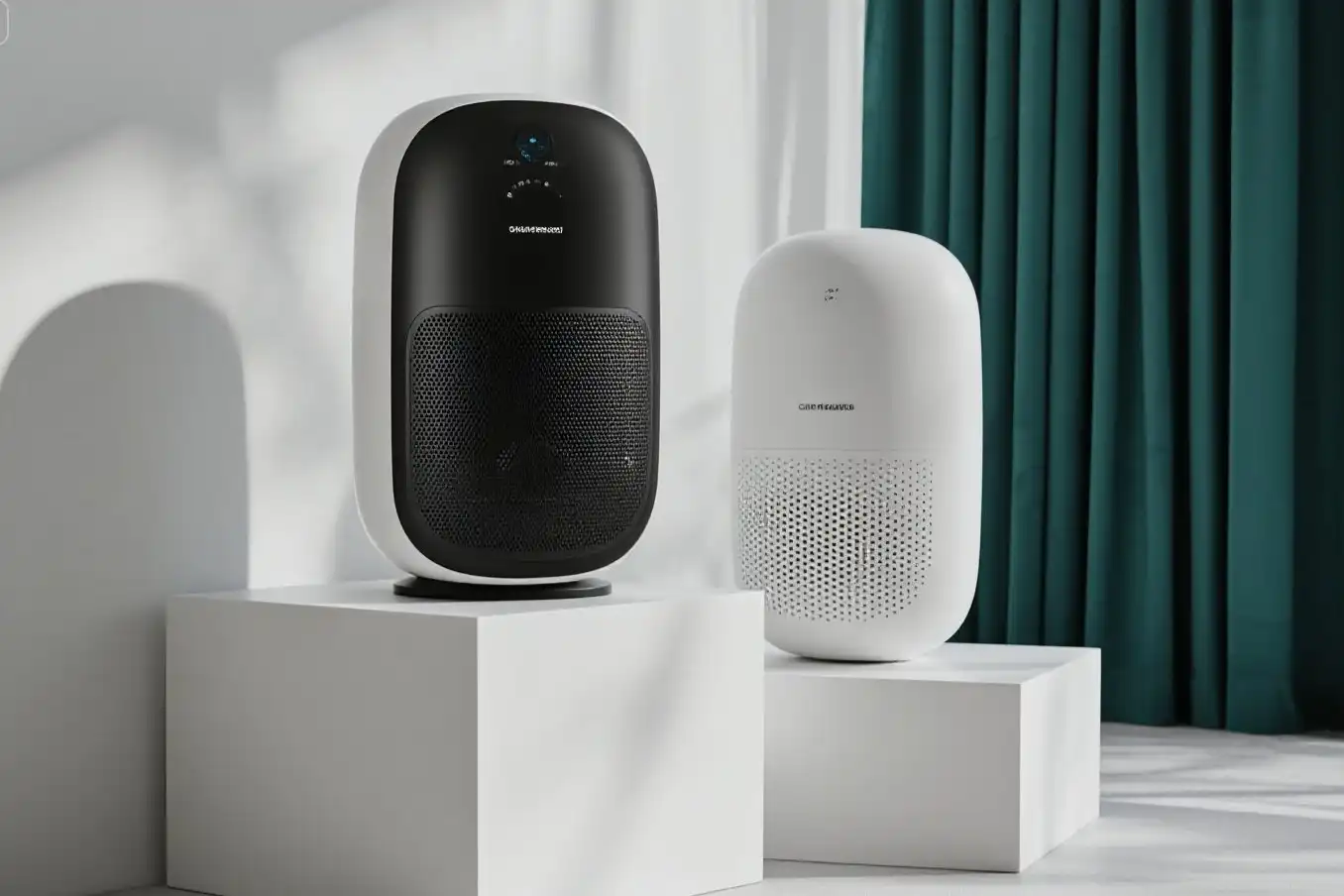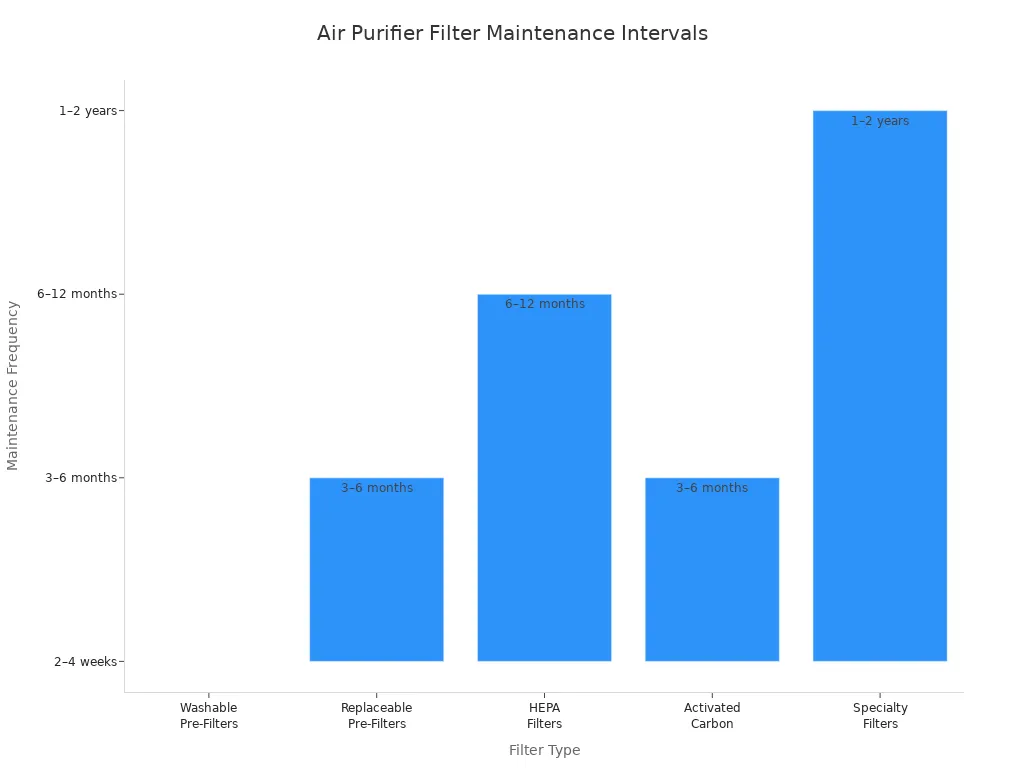
Choosing between an air sanitizer vs air purifier depends on your specific needs. If you want to reduce dust or allergens, an air purifier is the better choice. However, if your main concern is eliminating germs or viruses, an air sanitizer is more suitable. Poor indoor air quality can lead to serious health issues like asthma, heart disease, and even cancer. Since people spend about 90% of their time indoors, the risk of exposure increases significantly. The table below highlights how air pollution is expected to impact health in 2025:
| Statistic | Description |
|---|---|
| Population affected | 46% of people in the U.S. live in areas where outdoor air is unhealthy |
| Health risks | Increased cases of asthma, diabetes, and heart disease |
| Time indoors | People spend 90% of their time inside |
When deciding between an air sanitizer vs air purifier, consider both your health concerns and the environment you live in.
Key Takeaways
- Air purifiers use filters to take out dust, pollen, and allergens. This makes them great for people with allergies. Air sanitizers use UV light or sprays to kill germs and viruses. They help stop people from getting sick. Air purifiers with carbon filters are best for removing strong smells. These smells can be from smoke or cooking. Pick a device that fits your main need. Use an air purifier for allergies. Use an air sanitizer for germs. Use an air purifier with a carbon filter for odors. Make sure the device is the right size for your room. Follow the care instructions. Do not use models that make ozone because they are not safe.
How They Work
Air Sanitizer
Air sanitizers help get rid of germs and viruses at home or work. They use different science methods to clean the air:
- Ventilation: Air sanitizers bring in fresh air and push out dirty air. This helps get rid of bad stuff in the air.
- Filtration: Some air sanitizers have filters that catch dust and other things. Filters can grab big pieces, trap small ones, or use static to pull in charged bits.
- Ultraviolet Germicidal Irradiation (UVGI): Many air sanitizers use UV light to kill germs. UVGI breaks the DNA of germs so they cannot make you sick.
- HVAC Integration: Some systems mix outside air, many filters, and air conditioning to keep air clean.
All these ways help lower germs, viruses, and toxins in the air and on things.
Air Purifier
Air purifiers help take out dust, allergens, and other stuff from the air. Most new air purifiers use more than one way to clean air:
- HEPA Filters: These filters catch almost all tiny things like dust, pollen, and pet hair.
- Activated Carbon Filters: These filters take away smells, smoke, and harmful gases from the air.
- Advanced Technologies: Some air purifiers use PECO technology to break down bad stuff at a tiny level. They can get rid of viruses, bacteria, mold, and even chemicals.
Good air purifiers are checked for how well they work and how loud they are, so you can pick the right one.
Key Differences
| Feature | Air Purifiers (Conventional) | Air Sanitizers (e.g., WellisAir Disinfectant) |
|---|---|---|
| Mechanism | Use filters to catch particles in the air | Use chemicals and UV light to clean air and surfaces |
| Particle Removal | Catch very small particles | Kill germs, viruses, and toxins in air and on things |
| Technology Type | Use filters to clean air | Use chemicals and UV light to kill germs |
| Reliability | Not as reliable | More reliable |
| Power Consumption | Use more power | Use less power |
| Portability | Heavy and hard to move | Light and easy to move |
| Cost | Cost more | Cost less |
| Maintenance | Hard to take care of | Easy to take care of |
| Environmental Impact | May need to clean surfaces too | Safe for the environment |
Tip: Pick an air purifier if you want to get rid of dust and allergens. Pick an air sanitizer if you want to kill germs and viruses.
Air Sanitizer: Pros & Cons
Germs & Pathogens
Air sanitizers help stop germs and viruses at home or work. Many use UV light or sprays to kill bacteria in the air. Scientists tested a safe spray in rooms with bacteria like Staphylococcus aureus and Klebsiella pneumoniae. The spray worked fast and killed most germs in the air. It passed tough EPA and ASTM tests, so it is safe if you use it right. Other studies show air sanitizers with triethylene glycol vapor or UV light can lower germs in the air. In real tests, a 30-second spray in a bathroom cut viruses on surfaces and in the air by almost 99%. This means you can trust air sanitizers to help keep you from getting sick from germs in the air.
Allergens & Particles
Air sanitizers do not work well for dust, pollen, or pet dander. These devices are made to kill germs, not catch particles. If you have allergies, air sanitizers will not remove things that make you sneeze or itch. You might still see dust on your stuff or feel bothered by pollen in the air. For allergy help, you should get a device with filters, like a HEPA air purifier.
Odors
Some air sanitizers can help with smells, but their main job is to kill germs. They might lower smells from bacteria or mold, but they do not always get rid of strong odors from cooking, pets, or smoke. If you want to remove bad smells, you need a device with an activated carbon filter.
Safety & Maintenance
Note: Air sanitizers are usually safe if you follow the rules. The EPA has approved some sprays as safe for people and the environment. But you should know about some problems:
- Some electronic air sanitizers, like ionizers, can make ozone and other bad gases.
- Ozone can cause headaches and breathing trouble if there is too much.
- Some people say the air feels bad or they feel sick with some devices.
- Experts often say to use filters and fresh air instead of ozone-making devices.
You should also clean or change parts when needed. If you do not, the device might not work well or could spread germs. Always check the manual for care tips.
Air Purifier: Pros & Cons
Allergens & Dust
Air purifiers help lower allergens and dust at home. HEPA filters catch tiny things like pollen and pet dander. They also trap mold spores in the air. Many studies show air purifiers can cut down allergens. People with asthma or allergies often feel better using them. The table below shows what scientists found about air purifiers and allergies:
| Study (Author, Year) | Population | Key Findings |
|---|---|---|
| Wood et al, 1998 | Cat-allergic adults | Modest reduction in airborne allergens |
| Morgan et al, 2004 | Asthmatic children | Reduced asthma symptoms and allergen levels |
| Morris et al, 2006 | Hay fever patients | Significant symptom reduction |
| McDonald et al, Review | Various allergic patients | Symptom improvement, but some flaws in studies |
| Burroughs, 1998 | Residences | Enhanced filtration reduced particles effectively |
Tip: Air purifiers are best for allergens in the air. They cannot clean dust that sits on tables or floors.
Germs & Pathogens
Most air purifiers focus on catching particles, not germs. Some use UV light or special filters to fight bacteria and viruses. These features help, but they might miss some germs. UV light needs time to work well. Many home air purifiers do not give enough time. If you want to fight germs, pick a purifier with strong technology.
Odor Removal
Air purifiers with activated carbon filters can help with smells. They trap gases and odors from pets, cooking, or smoke. You must change these filters often to keep them working. Some gases, like ammonia or formaldehyde, may not be removed by all filters. Always check what the filter can do before you buy it.
Safety & Maintenance
Air purifiers are safe for most homes, but there are things to know:
- Mechanical filters work well but cost a lot to replace.
- Activated carbon filters need changing every few months.
- Ozone generators and some ionizers make harmful ozone. Consumer Reports says not to use them.
- Some new technologies, like PECO or PCO, may not work as promised and can make bad byproducts.
| Air Purifier Type | Potential Disadvantages |
|---|---|
| Mechanical Filters | Expensive; need replacement every 6-12 months |
| Activated Carbon Filters | Need frequent replacement; not effective for all gases |
| Ozone Generators | Produce harmful ozone; not recommended |
| Ionizers/Precipitators | Can produce ozone; may cause health concerns |
| UVGI/PCO/PECO | Limited effectiveness; may create harmful byproducts |
Note: Always follow the maker’s rules for cleaning and changing filters. This helps your air purifier work well and keeps your air clean.
Air Sanitizer vs Air Purifier
。Air-Sanitizer-vs-Air-Purifier-1024x682.webp)
Comparison Table
Here is a simple chart to help you compare both devices. It shows what each one does best and how they are different.
| Feature | Air Sanitizer | Air Purifier |
|---|---|---|
| Main Function | Kills germs and viruses | Removes dust, allergens, and particles |
| Best For | Illness prevention | Allergy relief |
| Odor Removal | Limited (mainly from germs/mold) | Good (with carbon filter) |
| Technology | UV light, sprays, or chemicals | HEPA, carbon, or advanced filters |
| Maintenance | Usually low; clean or refill as needed | Filter changes needed |
| Reliability | Good for killing germs | Good for long-term air cleaning |
| Portability | Often lightweight and easy to move | Some models are heavy |
| Safety | Some types may create ozone | Most are safe; avoid ozone models |
| Cost | Usually less expensive | Can cost more, especially with filters |
Tip: Use this chart to help you pick the right device. If you want to stop germs, choose an air sanitizer. If you want help with allergies, pick an air purifier.
Allergies
If you have allergies, you want to get rid of dust and pollen. Air purifiers are best for this job. They use HEPA filters to trap tiny things that make you sneeze. People with asthma or allergies feel better with an air purifier at home.
Air sanitizers do not catch these tiny things. They are made to kill germs and viruses. You might still see dust or feel bothered by pollen if you only use an air sanitizer.
- Air purifiers help you breathe better if you have allergies.
- Air sanitizers do not take allergens out of the air.
If you want help with allergies, air purifiers are the best choice.
Illness Prevention
It is important to stop germs and viruses from spreading. Air sanitizers use UV light or sprays to kill germs in the air and on things. They can help you stay healthy at home or work.
Air purifiers can help a little with germs if they have special filters or UV. Most air purifiers focus on dust, not germs. If you want to keep your family from getting sick, an air sanitizer works better.
- Air sanitizers kill germs and viruses in the air.
- Air purifiers may help with germs if they have extra features, but they work best for dust and allergens.
For stopping sickness, air sanitizers are the stronger choice.
Odor Control
Bad smells from cooking or pets can make your home less nice. Air purifiers with carbon filters do a good job taking away these smells. They trap gases and odors, so your air smells better.
Air sanitizers can help with some smells, mostly from bacteria or mold. They do not remove strong smells from smoke or food as well as air purifiers.
- Air purifiers with carbon filters remove most odors.
- Air sanitizers help with some smells but not all.
If you want to get rid of bad smells, air purifiers are the best pick.
Quick Reference: What Matters Most to You?
- Allergies: Air purifier is best.
- Illness Prevention: Air sanitizer is best.
- Odor Control: Air purifier with carbon filter is best.
When you compare air sanitizer vs air purifier, think about what you need most. Many people want devices that last a long time and are easy to care for. Some like air purifiers with washable or permanent filters because they save money. You might also care if the device is loud or easy to move. Some people worry about ozone from some air sanitizers or purifiers, so always check for safety before you buy.
Choosing the Right Device
Health Needs
Think about your health before you pick a device. If you have asthma or allergies, clean air is very important. Dust, smoke, mold spores, and pet dander can make you feel worse. Kids, older people, and those with lung problems are at higher risk. Here are some common air problems and which device helps most:
- Asthma or allergies: Use an air purifier with a HEPA filter. Try to find filters that have special allergy-friendly labels.
- Illness prevention: Air sanitizers help lower germs and viruses in the air.
- Odors or smoke: Air purifiers with carbon filters take away smells and gases.
You can use monitors to check for carbon monoxide, radon, and tiny particles. These tools help you know if your air is safe and what device you need.
Room Size & Placement
The size of your room matters for your device. Make sure your device matches your room’s size. Look for the Clean Air Delivery Rate (CADR) and the room size on the box. For best results, try to get 2 or 3 air changes every hour. Put your device in the middle of the room with space around it. In bedrooms, keep it 6 to 10 feet from your bed. In living rooms, place it near where you sit but not behind furniture or close to walls.
Tip: Use more than one device if your space is big or has many rooms.
Budget & Upkeep
Prices are different for each type and size. Here is a table with average prices in 2025:
| Device Type | Price Range (USD) |
|---|---|
| Portable Air Purifier | $100 – $1,000 |
| Whole-House System | $419 – $12,000 |
| Air Sanitizer | $100 – $1,000 |
Taking care of your device is important. Air purifiers need new filters often. HEPA filters last 6 to 12 months. Carbon filters need changing every 3 to 6 months. Some devices have filters you can wash. If you smell something bad, feel less air, or see a warning light, it is time to change the filter.

Decision Checklist
Here is a checklist to help you pick between an air sanitizer and an air purifier:
- Need help with allergies or dust? → Get an air purifier with a HEPA filter.
- Worried about germs and viruses? → Choose an air sanitizer.
- Want to get rid of odors or smoke? → Pick an air purifier with a carbon filter.
- Check your room size and match it to the device’s CADR.
- Think about how much you want to spend on the device and filters.
- Look for models that are easy to care for and have filter change lights.
- Think about what you might need later, like smart features or a whole-home system.
Remember: Install your device the right way and take care of it often. This keeps your air clean and your device working well.
When you look at air sanitizer vs air purifier, think about what you need most. Air purifiers are good for allergies and dust. Air sanitizers help stop germs and viruses. In 2025, new UV-C technology makes both safer and better. Always check what you need, how big your room is, and how much you want to spend. Clean air helps people feel good and miss less school or work. Pick the right one for a healthy home!
FAQ
What is the main difference between an air sanitizer and an air purifier?
Air sanitizers kill germs and viruses in the air. Air purifiers take out dust, pollen, and other small things. Pick the one that matches your biggest worry—germs or stuff that causes allergies.
Can you use an air sanitizer and air purifier together?
Yes, you can use both in one room. This gives you cleaner air and fewer germs. It helps if you want to stop allergies and sickness at the same time.
Do air sanitizers or purifiers remove smoke and strong odors?
Air purifiers with carbon filters get rid of smoke and most smells. Air sanitizers help with odors from germs or mold but do not clear strong cooking or smoke smells.
Tip: For the best way to remove bad smells, choose an air purifier with a carbon filter.
Are air sanitizers safe for kids and pets?
Most air sanitizers are safe if you use them right. Stay away from ones that make ozone. Always look for safety labels before you buy.
See also
Are Air Purifiers Effective for Relieving Chronic Stuffy Nose
How Humidifiers Impact Dust and Cleanliness in Your Space
